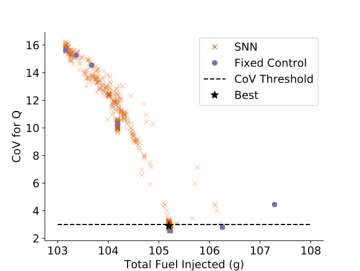
Achievement
A multidisciplinary team of researchers from Oak Ridge National Laboratory (ORNL) demonstrated a complete pipeline for neuromorphic computing at the edge, including a small, inexpensive, low-power, FPGA-based neuromorphic hardware platform, a training algorithm for designing spiking neural networks for neuromorphic hardware, and a software framework for connecting those components. They demonstrated this pipeline on a real-world application, engine control for a spark-ignition internal combustion engine. They illustrated how the connected engine simulations with neuromorphic hardware simulations and training software produced hardware-compatible spiking neural networks that perform engine control to improve fuel efficiency. They presented initial results on the performance of these spiking neural networks and illustrate that they outperform open-loop engine control. They also gave size, weight, and power estimates for a deployed solution of this type.
Significance and Impact
By utilizing low power AI hardware such as neuromorphic systems, more efficient engines can be enables, which can potentially lead to a reduction in greenhouse gas emissions. In this work, researchers show that it is feasible to utilize a spiking neural network approach as deployed on neuromorphic hardware to control an engine in simulation. They show that even this preliminary spiking neural network approach can outperform current, open-loop control strategies. Moreover, they demonstrate that the resulting spiking neural networks are very small and sparse and can be deployed onto an inexpensive and low size, weight, and power commercial field programmable gate array (FPGA), providing the opportunity for rapid deployment.
Research Details
- Developed a complete workflow to train a spiking neural network (SNN) to deploy to an FPGA-based neuromorphic hardware system for internal combustion engine control.
- Workflow includes a low cost FPGA-based neuromorphic hardware system called uCaspian, a spiking neural network training methodology called EONS that integrates with the engine simulation code, and a neuromorphic software workflow based on the TENNLab software framework to connect each of the components together.
- Spiking neural network-based approach outperforms fixed control strategies in terms of fuel efficiency in simulation while still meeting acceptable performance metrics.
- The uCaspian implementation of this spiking neural network is estimated to consume between 10 mW and 20 mW.
Citation and DOI
Catherine Schuman, Steven Young, J. Parker Mitchell, J. Travis Johnston, Derek Rose, Bryan P. Maldonado and Brian Kaul. “Low Size, Weight, and Power Neuromorphic Computing to Improve Combustion Engine Efficiency.” AI at the Edge Workshop, International Conference on Green and Sustainable Computing.
Overview
Neuromorphic computing offers one path forward for AI at the edge. However, accessing and effectively utilizing a neuromorphic hardware platform is non-trivial. In this work, researchers present a complete pipeline for neuromorphic computing at the edge, including a small, inexpensive, low-power, FPGA-based neuromorphic hardware platform, a training algorithm for designing spiking neural networks for neuromorphic hardware, and a software framework for connecting those components. This pipeline is demonstrated on a real-world application, engine control for a spark-ignition internal combustion engine. Engine simulations are connected with neuromorphic hardware simulations and training software to produce hardware-compatible spiking neural networks that perform engine control to improve fuel efficiency. Initial results on the performance of these spiking neural networks illustrated that they outperform open-loop engine control.
Last Updated: February 17, 2021 - 10:07 am